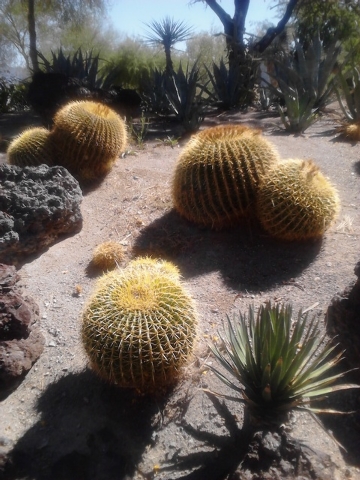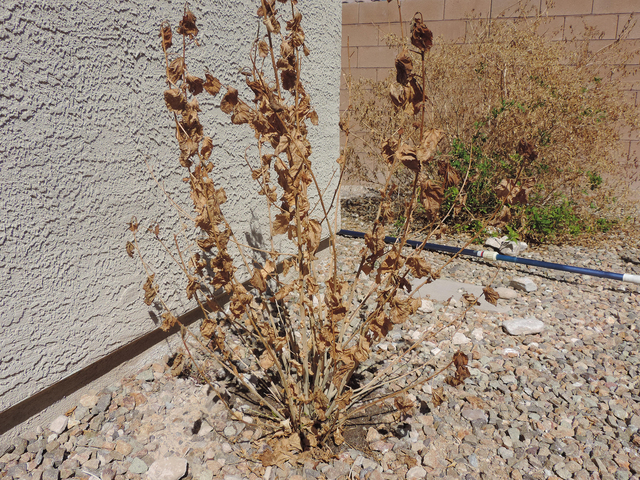Less water, better drainage will help barrel cactuses recover
Q: Over the years I planted perhaps 10 different golden barrel cactuses. Nearly all died the same way. I first notice a hole in the main body of the plant; it looks like a rodent gnawed the hole, but I have never found anything inside the plant.
The plant retains its color and appears healthy. After about a year, the root system is gone and I remove the plant.
Can you explain?
A: When I lose a barrel cactus that way and the hole is at the bottom of the plant, it is usually from poor soil drainage and watering too often. The roots rot as well as the interior. Reduce the frequency of your watering and make sure the soil drains extremely well.
If you catch the problem early enough, you can arrest the damage by shutting off the water until the plant recovers. After that, water less often.
If your barrel cactuses are watered more than once every two weeks, that might be the problem. These plants rely on storage water during times of water shortages. The size of the plant increases after a heavy rain and decreases when water is scarce because of the stored water.
The only creature that I would think might be interested in barrel cactus and might be able to damage them are ground squirrels. But they usually harvest fruits from them, not the fleshy interior.
Q: I live in North Las Vegas and am considering a vegetable garden in my backyard when I retire in January. I have adequate space on the east and the west side of the house, however, the west side has a high wall that blocks off the afternoon sun. Which side would be best for the garden?
A: I think of growing areas in the yard in terms of microclimates. It sounds as if you might have two different microclimates going on: the warmer but shadier west side and the cooler east side.
I would consider having growing beds on both sides if they are significantly different in their environments. These two different microclimates can extend your production by a couple of weeks or more in the spring and fall — earlier spring and later fall production in the hotter microclimate and later spring and earlier fall production in the cooler one.
Reflected light also counts as light that benefits plants as long as it is bright enough. I wouldn’t discount the west area simply because you have a wall on the west side. I would consider painting these walls to reflect more light or cover their surfaces for the same reason.
Think back to when you have been in both of those areas. What were your impressions regarding their different microclimates? Was one microclimate quite a bit different in seasonal temperatures than the other? If these microclimates are so similar that you don’t get any advantage, I would put your garden on the east side.
Q: We have three healthy bottle trees in our front yard. However, one has a very dominant branch that sticks out much farther than the others and the tree looks quite lopsided. My other two bottle trees are pretty balanced. What should I do?
A: The lopsided bottle tree is planted pretty close to the house. Plants grow away from shade toward the light and become lopsided. The side away from the house is denser and has more growth than the side toward the house.
This is a normal reaction by plants to shade; they want to gather as much light as possible so they “grow into” areas that provide more light. Their growth is uneven because the light supplied to them is uneven.
The only way to balance the canopy is to remove growth on the side that makes it lopsided. When you remove growth, you do not simply cut it back with a shears or cut it off like a dead end.
You identify limbs that are the longest and remove the entire limb where it joins a branch that is shorter. This reduces the canopy’s density and won’t cause future growth problems.
By selectively removing the long branches and leaving the shorter branches, the canopy’s size is reduced. Also, removing limbs all the way back to another limb keeps them balanced.
It is not too late to remove a few branches in March.
Q: I’m forwarding pictures of my hibiscus that turned brown over the winter. It looks as if there’s growth on two of them, but the others look grim.
Should I give them a chance to grow or start again? Also, if I do try to let these live should I trim them to the ground?
A: It looks as if your hibiscus got hammered this past winter. And this winter wasn’t really that cold. These are most likely tropical hibiscus.
Hibiscus is a common name for a number of different plants with different attributes. These range from the tropical hibiscus to plants that we call hibiscus but are winter-hardy in our climate.
Your hibiscus was probably one of the tropical or subtropical types. Judging from your picture, the soil looks as if it was hardly improved at all and rocks are strewn along the surface. These issues must be addressed if you expect these plants to thrive at all in the future.
They need a lot of soil amendment added at the time of planting. Although they can handle a lot of heat, they cannot handle the extreme heat and low humidity of unshaded south and western microclimates of the Mojave Desert.
They will look best when protected from late-afternoon sun and when the soil is covered with organic mulch. They also will do better if surrounded with plants that also need moist, organic soils.
I would cut them to the ground in the spring, fertilize and water them and see if they will come back. Pull the rock away from them and put down a layer of compost about 1 inch thick followed by 3 inches of wood mulch on the surface. Keep the wood mulch away from the stems of the plants by about 12 inches.
In the future, you will treat them like herbaceous perennials; let them grow during the warm, hot months and cut them to the ground after they freeze back. Pile mulch around their base that is 3 inches to 4 inches deep. This may be enough to minimize winter cold damage.
Q: One of my Carolina cherry trees has some branches with brown leaves and the branches were easily broken off. There is an area of the main trunk, about halfway up the tree, which is very black.
A: I receive a number of questions regarding the poor appearance of or damage to Carolina cherry trees. The plant struggles here mostly because it is native to the Southeastern United States, where soils are rich and moist.
These trees will struggle here if they do not receive TLC. The other problem may be where they are planted.
Your Carolina cherry laurel most likely has been damaged by the intense sunlight of our desert Southwest. When damaged by strong sunlight, we see limb and branch dieback accompanied by leaf drop.
Often this damage is black with brittle limbs and bark that peels. Frequently the tops of these trees will die, too. They tend to look very sparse in our climate and soils.
Because this plant isn’t a Southwestern U.S. native, we have to be careful with it here. When planting it, the soil must be enriched with compost at the time of planting and the soil surface should be covered with wood mulch, not rock mulch.
These plants struggle in very hot locations. This includes the south and west exposures of the landscape particularly close to the very hot walls. They perform better if clustered with other plants with similar soil and water requirements.
They may develop yellow leaves, which would be corrected by applying an appropriate iron fertilizer. I always recommend the iron chelate EDDHA. It is stable when applied to the soil regardless of the alkalinity. This is not true of other iron fertilizers.
Bob Morris is a horticulture expert living in Las Vegas and professor emeritus for the University of Nevada. Visit his blog at xtremehorticulture.blogspot.com. Send questions to extremehort@aol.com.






























